The One Edit That Would Make 'North By Northwest' Perfect
by Josh Fruhlinger
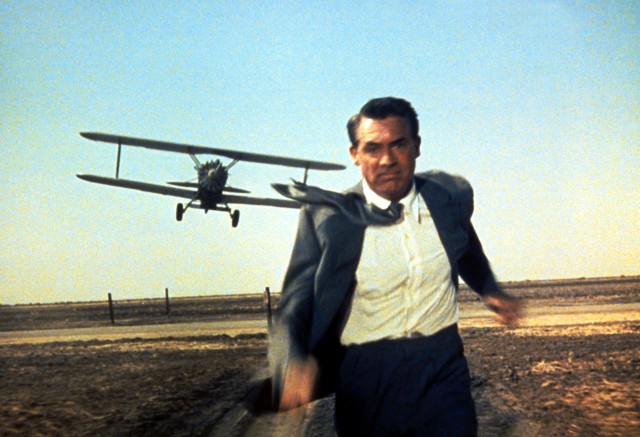
North By Northwest is fantastic. Can we agree on this? I hope so. If you disagree, you’re probably a perfectly nice person, but I’m afraid you are factually incorrect on this point, and I’m not going to deign to argue with you. Sorry. “Propulsive” is a word that has been beaten to death by movie critics, but really, the plot gets underway immediately — Cary Grant is kidnapped less than four minutes after the opening credit sequence ends — and does not really let up for the next two wonderful hours.
As the Oscars draw near,
the first in a series about our strong movie opinions, past and present.
Because North By Northwest is so fantastic, I have seen it many times. I try to see it whenever a revival is showing at a nearby movie theater, and if I stumble upon it while channel surfing (something that happens more often than you’d think to a guy who doesn’t have cable) I invariably watch it to the end. Which means I’ve thought about the movie a lot. Now, this next sentence should not be read as me backing off one iota from my earlier assertion that the movie is fantastic and you are wrong if you disagree, but I’ve wondered: could it be made even better, by someone moderately more skilled with video editing software than I am? Over my twenty years or so of not infrequent North By Northwest watching, I have developed a theory that it could. Beware: If you somehow have gotten to 2013 and haven’t seen this movie but still want its surprises fresh for you when you finally get around to seeing it, spoilers follow from here. Ironically, I need to talk about the spoilers to talk about my theory, which involves removing spoilers from the movie itself.
The plot is based on one of Hitchcock’s favorite gimmicks: the ordinary man thrust into dangerous and exciting circumstances due to a case of mistaken identity. In this case, Roger Thornhill (Cary Grant, exasperated wit) is kidnapped by and almost killed by the henchmen of Philip Vandamm (James Mason, languorous creep). Vandamm’s crew all insist that Thornhill is actually someone named George Kaplan. For the first forty minutes or so of the movie, while Thornhill isn’t busy trying to keep from getting killed, he’s trying to figure out who the real George Kaplan is. One of the great joys of the movie is watching Roger Thornhill, in his attempt to prove he isn’t George Kaplan, pretend to be George Kaplan. There’s a sequence where Thornhill and his mother bluff their way into the absent Kaplan’s hotel room, checking out his bathroom (dandruff shampoo) and trying on his suit (too small). The film’s opening act ends with Thornhill fleeing after a dead body lands in his arms in the middle of the U.N. building.
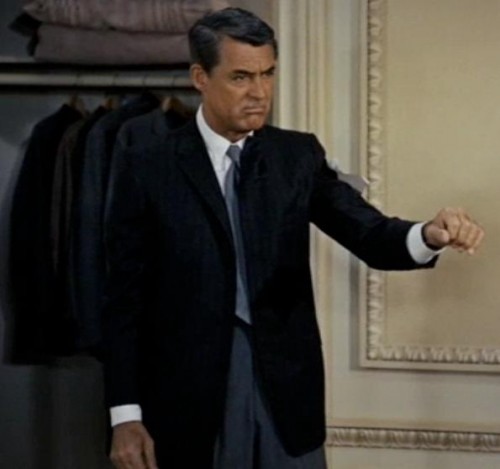
Immediately afterwards comes what is undoubtedly the worst, most awful scene in a great movie. After forty minutes of non-stop action, everything suddenly grinds to a halt so that we can be treated to some exposition down at CIA headquarters, delivered in the worst possible format: a bunch of people, none of whom we’ve seen before, sitting around a conference table telling each other things they already know. The scene’s only three minutes long, but it seems to last forever.
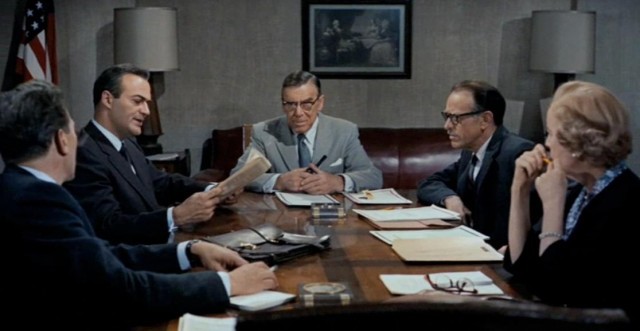
Anyway, as we learn, the deal with George Kaplan is that he doesn’t exist. The spymasters are renting hotel rooms in his name and leaving prop belongings in them in all the cities where Vandamm is going, because they want him to believe that he’s being tailed by a spy named George Kaplan. Focused on this elusive secret agent, Vandamm won’t suspect the “actual agent” who’s “working under Vandamm’s very nose.” The dialogue withholds this spy’s identity as artificially as it reveals everything else, but it does at least leave one mystery for us.
After this blah-blah ends, we cut back to Thornhill, who’s managed to escape from the U.N. to Grand Central Terminal. He gets on the 20th Century Limited, and in short order, is hidden away from the cops by Eve Kendall (Eva Marie Saint), has sex with Eve Kendall, and is sent off to be killed by Eve Kendall, who turns out to be Vandamm’s girlfriend. Surviving the attempt, he doubles back, finds the plotters, berates them at an art auction, then gets himself arrested because he’s finally decided he’ll be safest with the cops; the cops then hustle him to the airport and hand him over to the Professor (Leo Carroll), one of the spooks from the earlier terrible exposition scene.
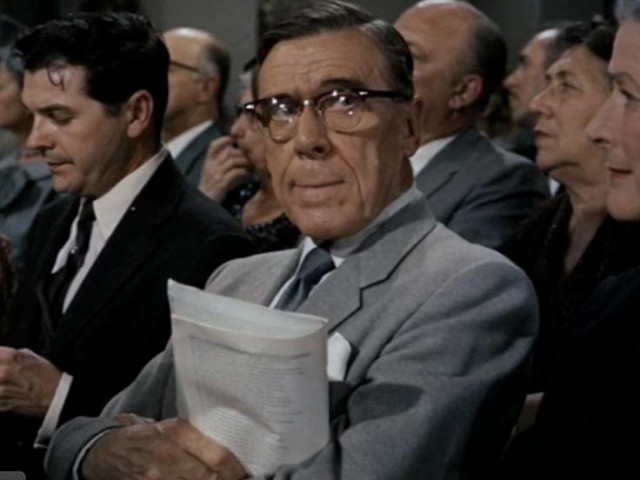
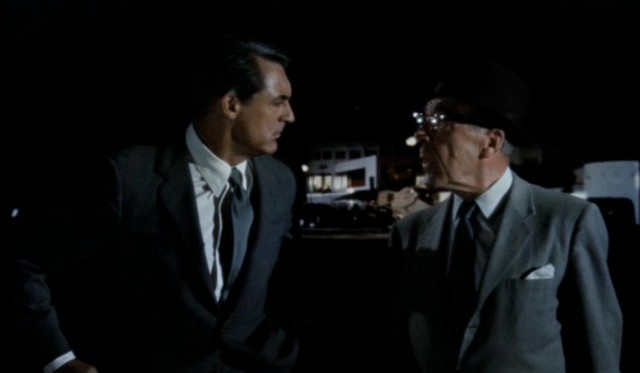
This all takes another 55 minutes or so, and it’s 55 minutes that loses some of the immediacy of the first act, because, while we’re watching Thornhill pursue Kaplan, we know that Kaplan doesn’t exist. We’re treated to a different and, of course, perfectly respectable sort of dramatic tension — not so much “What will happen?” as “When will he learn what is happening?” — but it causes a bit of a downshift in intensity nonetheless. The Professor finally reveals what’s been happening to Thornhill as they cross the tarmac to get on a plane headed for South Dakota; most of the information that would be a straight-up repeat of exposition from the earlier scene is drowned out by the plane’s propellers, a touch I have always assumed to be intentionally hilarious. (We also lean that Eve Kendall is the real American secret agent; the rest of the movie involves rescuing her from Vandamm’s clutches.)
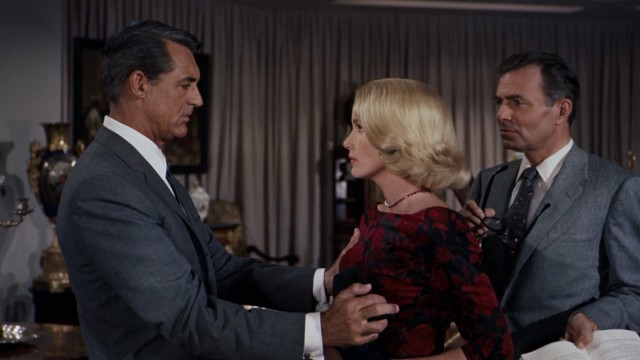
These two sections of exposition break the film into three acts, and the levels of knowledge held by the audience and protagonist are structured differently in each. To start, we and Thornhill are equally in the dark; then in the middle, we know the crucial data that he doesn’t; and finally, everyone knows everything and we’re ready to confront the bad guy together. While this is interesting formally, I (along with Eve Kendall) believe that being the dark with Roger Thornhill as long as possible is more fun.
And, tantalizingly, such a version of the film is within our reach. The first, and most obvious step, is to cut out that early terrible scene at Boring Spy HQ entirely. Just cut it! There are plenty of fascinating and hilarious minor characters in the movie who only get one or two lines, but none of them are in that scene. The only one we ever see again is the Professor, and he has to re-introduce himself to Thornhill when they meet anyway. A bit before his reappearance, the Professor pops up in the crowd at the art auction scene. The camera lingers on him now and again, to remind you that you know who he is, but if you didn’t, it wouldn’t make the scene weird, and it would create a moment of recognition when you meet him a few minutes later.
But we do need some of the information in that first exposition scene, right? Yes, but less than you might think. Much of the dialogue there rehashes the plot up to that point, and much of what we do need to know is repeated in the audible parts of the airport scene. The rest could be packed into a couple of sentences, like:
“We created George Kaplan, established elaborate behavior patterns for him, moved his prop belongings in and out of hotel rooms, labored successfully to convinced Vandamm that this was our own agent hot on his trail. If we make the slightest move to suggest that there is no such agent as George Kaplan — give any hint to Vandamm that he’s persuing a decoy instead of our own agent, then our agent, working right under Vandamm’s very nose will immediately face suspicions.”
Fortunately for us, the Professor says those very words (though not quite in that order) in the first exposition scene, and someone with more video editing skills than me could perhaps just drop them into propeller-fuzzed section of the airport scene And then, ta-da! A great movie gets even greater.
Hitchcock famously popularized the term “MacGuffin” to refer to an object that motivates the characters but that the audience doesn’t really care about. In North By Northwest, the MacGuffin is a tiny pre-Columbian statue with microfilm in its gut that Vandamm is going to take with him to Russia. It’s such an advanced version of its type that the viewer barely even thinks about it.
If there’s a mystery we care about, it’s George Kaplan. There are moments when he seems within our grasp — when Thornhill tries on his suit, when Kendall says she’s talked to him on the phone. Perversely, finding out that he was never there is delightfully satisfying. I just think it’d be even more delightful if we had to wait another hour or so to find out.
Hitchock-related: How To Get Your Lion Back When It Runs Away: Life Lessons From Tippi Hedren
Josh Fruhlinger thinks the trout is a little trouty. Follow him on Twitter or Tumblr.
Fox News Replaces Idiot With Another Idiot
When Fox News got rid of Sarah Palin by offering her a very tiny contract renewal, people who follow these things said, “Oh, Fox News has been forced to scale back the crazy a little bit, because the old white lunatics are quickly dying off and America’s population now consists solely of multi-ethnic transgender metrosexuals.” But these people were wrong, because Fox News just hired Herman Cain as a paid on-air personality.
Herman Cain was the 2012 GOP presidential frontrunner at some point — everybody was a GOP frontrunner at some point, except for Sarah Palin. Imagine being such a washed-up dingbat that you couldn’t even compete with the likes of Rick Perry and Michele Bachmann.
The cable news station also hired Scott Brown, who was “the new Ted Kennedy” for about five minutes back in 2010.
This Week's Winners and Losers of New York City's 2013 Mayoral Election

Let’s look at the winners and losers of this week in the reality show that is New York City Mayoral Election 2013!
It was a quiet week in the mayoral campaign. Why is that? Because it’s all already basically a done deal, pretty much. The Republicans are fighting it out towards a primary, instead of settling on a candidate, which is fine. We’re all basically pretending that there’s an active race and that anything could happen! Well, it could… maybe. There’s the people with the money and there’s the people without the money. Once again. Polls describe everyone as substantially lagging behind Quinn.
• Mike Bloomberg Mayor Mike delivered his 12th state of the union address yesterday (man!) and it was a real mixed bag. Unfortunately he came out hard with his love of stop and frisk. He just loves some stop and frisk. That sucks about him. And then? He gamified federal disaster relief money. That’s right: “$145 million of the first $1.77 billion in federal Hurricane Sandy funds will go to the winners of three contests.” OH but wait, back to that speech: “He pointedly chastised the Democratic lawmakers sitting before him for failing to support his efforts to break the union representing striking school bus drivers, hinting that the officeholders were beholden to organized labor.” SIGH.
• Christine Quinn: Mixed bag! On the one hand, her proposal for affordable housing in the city is tax cuts for landlords, which MIKE BLOOMBERG DESCRIBED AS TOO FRIENDLY TO LANDLORDS, which, WOW. But then! “City Council Speaker Christine Quinn triumphed in a legal battle against Mayor Bloomberg Thursday as a court struck down the mayor’s new stricter rules on who can stay in homeless shelters.” And also: a weird flip-flop on congestion pricing. How ODD. GET IT TOGETHER GIRL.
• Bill de Blasio: Quite rightly trashed Quinn’s landlord liplock. De Blasio also announced he wanted to tax all rich people (“rich people” = people making more than $500K a year) to institute a universal pre-K program for all four-year-olds. SAY GOODBYE TO YOUR DONOR BASE. LOSER.
• Tom Allon: “Kudos to the mayor on #Sandy small biz recovery help,” he tweeted this week. That’s about it. LOSER.
• Bill Thompson: Trashed Quinn’s speech this week. He also gave a speech himself in which he warned of the emergence of a “permanent under-class.” Do you know who reported on this speech? NO ONE. Sigh. Bill Thompson, I dunno, don’t use the same team you worked with last election, you were basically invisible, and you shouldn’t have been. This is ridiculous. COME ON DUDE.
• Joe Lhota: *silence*
• John Catsimatidis: Haha, he wants to “save education” by entrenching a two-tier system where “failing” students get shunted into vocation systems, because they are too scared of calculus or something, so we can make sure we do create a permanent servant class. LOSER.
• George McDonald: *wind whistles through empty canyon, tumbleweed blows by* LOSER.
Meteor Explodes Over Russia, Russian Church Leaders Blame God
It was probably unrealistic to expect the apocalypse to start right on time at the end of 2012 — especially if it starts in Russia, where Christmas is two weeks late. So, here it is, a giant meteor (or meteors?) filling the skies over the Ural Mountains, and injuring nearly a thousand people.
But what do the religious leaders of Russia’s Orthodox Church have to say about this terrifying incident? Well, being gloomy Russians, they are just blaming it on the God they worship:
A meteorite which injured hundreds of people in Russia’s Chelyabinsk Region on Friday was “the Lord’s message to humanity,” a senior local clergyman said. “From the Scriptures, we know that the Lord often sends people signs and warnings via natural forces,” Metropolitan of Chelyabinsk and Zlatoust Feofan said in a statement released on Friday.
Oh and this has nothing to do with the asteroid that’s zipping very closely past the Earth today, at 2:25 p.m. Eastern time. Different thing entirely! And you can watch that right here, as it happens. Wear a helmet!
UPDATE: So many more weird Russian meteor videos coming in now. What’s with the explosions and pops after the big meteor crossed the sky?
Look at everybody standing by the snow piles outside their Soviet-era apartment blocks pointing their cell phones at the sky, as mysterious booms continue and all the car alarms go off. It is notable here that there’s almost none of the “Oh my God!” and shrieking you hear in American videos of such terror from the skies.
In Russia, meteor kills you. (This is an old Norm MacDonald joke.)
Another pirated copy of Cloverfield .
She'll Be Eating Six White Horses When She Comes
“The scandal over horse meat in the European food chain widened Thursday from a case of mislabeling to one of food safety as public health authorities in Britain said that a powerful equine painkiller, potentially harmful to human health, ‘may have entered the food chain’” — but only in France, so phew. In related news, the Guardian headline “Horsemeat scandal: ‘fresh beef’ discovery as tests overwhelm laboratories” might lead one to think that analysis had discovered some actual beef mixed in with all the ground-up stallion, but alas, no: “tests revealed potentially dangerous contamination of meat with veterinary drugs and Asda confirmed the first trace of horse had been found in a fresh beef product.” It is getting to the point where the whole idea of eating meat seems increasingly more risky and disgusting: maybe we should all just switch to fish. Or, uh, maybe not.
Tim Dog, 1967-2013
“In 1991, great rappers were a dime a dozen, good ones weren’t good enough to compete, and sucky ones made hits. But what about rappers who weren’t skilled, but immensely entertaining? Twenty years later, ‘personality rap’ pays the bills and that term usually applies to the majority of likable rappers that can’t really rap worth a shit (insert just about any current acclaimed rapper here). Tim Dog got points for being both bold and the poster child for Mayor David Dinkins-era NYC — an NYC overrun with robberies, racially-charged fights, and hair-trigger violence — but most people back then said the same thing with regard to his skill level: ‘Yeah, but he can’t rap.’ NYC’s infatuation with lyrical skill caused them to overlook one of the most ground-breaking and important albums in its history. Penicillin on Wax enjoys more appreciation on YouTube two decades later than it did at the time of its release. (Despite Sony’s claims that it went platinum, it’s still impossible to find on CD today.) What the naysayers didn’t understand was that Tim Dog’s modus operandi was not one of lyrical dexterity, but brute force. In 1991, brute force embodied the streets of New York and balanced out the ‘Prisoners of War’ and ‘Verses from the Abstract’ type of songs. Instead of being cerebral, brute force rap beat you in the cerebrum with a baseball bat. This wasn’t hip-hop; it was rap. Rap was bold, vulgar, hard, alpha male, gold rope-wearing, chest-beating shit, not the more eclectic stuff you played for critics to prove that all rappers weren’t ignorant hooligans.”
— Bronx legend Tim Dog, one of the more interesting and divisive artists in rap’s interesting and divisive history, died of a seizure yesterday. Ego Trip’s J-Zone wrote a really good essay about him two years ago. Tim Dog was 46.
Mayor Dislikes Styrofoam
“Bloomberg is expected to use part of his address to push initiatives that would increase the number of parking spaces for electric cars and begin recycling more plastics and food waste. The mayor who has taken on smoking, sugary drinks and salt is also expected to talk about working with the City Council to ban Styrofoam food packaging from stores and restaurants.”
— Just 12 years into his life term as mayor, Michael Bloomberg is now coming for your takeout containers.
This Weekend: AM Homes or AS Byatt; Yo La Tengo or Stephen Tobolowsky; Death by Asteroid
It’s a weekend, come one, we all now you’re just going to sit home and do drugs and wait for the end time and freak out. (Or go outside.)
The Man Behind The Brilliant Media Hoax Of "I, Libertine"
The Man Behind The Brilliant Media Hoax Of “I, Libertine”
by Matthew Callan
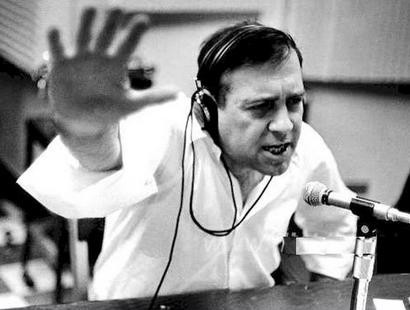
In the 1950s, a DJ named Jean Shepherd hosted a late-night radio show on New York’s WOR that was unlike any before or since. On these broadcasts, he delivered dense, cerebral monologues, sprinkled with pop-culture tidbits and vivid stretches of expert storytelling. “There is no question that we are a tiny, tiny, tiny embattled minority here,” he assured his audience in a typical diatribe. “Hardly anyone is listening to mankind in all of its silliness, all of its idiocy, all of its trivia, all of its wonder, all of its glory, all of its poor, sad, pitching us into the dark sea of oblivion.” Shepherd’s approach was summed up by his catchphrase: a mock-triumphant “Excelsior!”, followed by an immediate, muttered “you fathead…”
Shepherd inspired fierce loyalty in his listeners who would tune in to listen to him in the middle of the night. These listeners embraced his term for them, “night people,” and under his direction they would execute one of the biggest and most bizarre media hoaxes of the 20th century. The hoax was meant as a strike against their opposite: “day people,” that is, against phoniness and squareness — all those 50s words — as well as a joke on New York pretension.
In our time of memes, virality, and reality blurring, the hoax Shepherd dreamt up seems extremely modern and prescient in its contours — as does the fact that, eventually, it got out of his control.
THE WORLD’S BRAINIEST DISK JOCKEY
Shepherd grew up in Hammond, Indiana, a steel-mill town just outside of Chicago that would serve as the backdrop for many of his radio tales. He was a precocious amateur radio enthusiast and put his skills to good use in the army signal corps during World War II. Immediately after the war, Shepherd tried to catch on as a program host at various frequencies in markets such as Toledo, Philadelphia, and Cincinnati. His radio work displayed an uncanny sense of the absurd, a grasp of Americans’ shared cultural experience, and a keen recognition of the pull of childhood memories. The latter were suffused not with nostalgia, but with the undercurrent that perhaps childhood was more terrifying than you might care to remember.1
In his early gigs, Shepherd displayed a propensity to, quite literally, talk himself out of a job. While the occasional local newspaper puff piece might refer to him as “The World’s Brainiest Disk Jockey,” those brains hardly made him a hit with management, who handed him his pink slip numerous times for not playing enough records. His bosses wanted someone to spin the latest hits and keep the chitchat at a minimum. Shepherd had something else in mind entirely.2
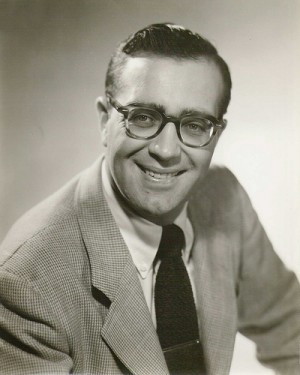
At Cincinnati’s WLW, he tried his hand at television, crafting a bizarre late-night show called “Rear Bumper,” a prehistoric precursor to the likes of Ernie Kovacs and Monty Python. On the program, he performed odd stunts: one time he had a cameraman pursue him through a maze as he delivered one of his typically dense, rambling monologues. (The cameraman never did find him before the show ended.) The show garnered him a fair bit of attention from critics, at least those who could stay up late enough to catch it. (Shepherd liked to joke that he came on the air after the National Anthem.)
By then age 34, married and a father, Shepherd made a break for New York and the big time in 1955, landing a Saturday afternoon show on WOR. It was not an ideal fit for him. WOR’s flagship show at the time was “Rambling with Gambling,” a morning program of weather, light news, and other featherweight fare for housewives and commuters. The rest of the programming schedule was similarly bland. And then along came Shepherd. Profiled in the New York Post by columnist Earl Wilson, he announced that the goal of his program was to “use radio the way a writer uses a sheet of paper: to say what he has to say about the world.” This ambition did nothing for WOR’s midday listeners, who stayed away in droves.
In January 1956, WOR quietly slid Shepherd into a graveyard slot: 1 to 5:30 am, every weeknight. Not only were the hours terrible, the move effectively exiled him from the station. Because WOR didn’t want to incur the expense of keeping its Manhattan studio open during the wee hours, Shepherd was forced to broadcast directly from its transmitter in Cartaret, New Jersey. As Eugene Bergmann recounts in his biography, Excelsior, You Fathead: The Art and Enigma of Jean Shepherd, conditions were cramped and hot, with Shepherd sitting in an unventilated room in the Meadowlands, uncomfortably close to 50,000 churning watts. “I’m sitting out there wearing a pair of Fruit of the Loom jockey shorts,” he’d say later.
He regularly asked his audience to join him in an exercise he called “Hurling Invective.” Listeners were instructed to put their radios on open windowsills and turn up the volume, loud enough for the neighbors next door to hear.
Here, however unwittingly, WOR created the ideal circumstances for Shepherd to come into his own. The slot was long — 4-and-a-half hours — and with those oceans of time to fill, Shepherd could stretch out for the first time, illustrating his stream-of-consciousness philosophical meanderings with tales of his kid-dom and asides into what he called “Dynamic Trivia”: oddball stories that somehow found their way into the newspaper and pop culture tidbits, such as the original cast of characters of the comic strip “Blondie.” Those who knew the answers to his questions were awarded the imaginary but very impressive-sounding Brass Figlagee with Bronze Oak Leaf Palm.
The dark, probing monologues that turned off midday audiences were a hit with those who listened at 2 a.m. Jean Shepherd became a favorite among the Beat movement, the emerging “Sick” Comedy scene, and jazz artists. Jack Kerouac and Lenny Bruce were both early, vocal admirers. Young creative types and other obsessives would listen to him deep into the night from their bedrooms, transistor radios tucked under their pillows.
And Shepherd fed off his listeners’ energy, using their anger and ennui to fuel his grand ideas. He regularly asked his audience to join him in an exercise he called “Hurling Invective.”3 Listeners were instructed to put their radios on open windowsills and turn up the volume, loud enough for the neighbors next door to hear. He’d then shout out a vaguely insulting non sequitur (“You filthy pragmatist!” a typical example), then immediately switch over to a powerfully “square” record (something Mantovani-ish) as a cover up. The idea being that if a neighbor had heard the insult, the listener could play dumb: “I was just listening to some music. Sure, I’ll turn it down.”
Through segments like Hurling Invective, Shepherd acted as his listeners’ proxy, someone who would air their frustrations for them. “This voice will carry your sentiments, your repressions, your aggressions, into the darkness out there, that void, where they’re lying in wait,” he told them.
THE STRUGGLE OF NIGHT PEOPLE AGAINST DAY PEOPLE
As summer approached, Shepherd hammered with greater frequency at the essence of what separated his nocturnal audience from the daytime world. He came to the conclusion that the people who thrived in the daytime&mdahs;the people not up at this ungodly hour — were enamored of order, in love with lists, obsessed with the idea of Making It. By contrast, his listeners had rejected such pursuits.
If Shepherd didn’t coin the term “Night People” — some slang dictionaries give him credit for doing so — he was almost certainly the first to ever deploy it in starkly Us vs. Them terms.
Here’s how Shepherd would later describe the difference between Night and Day People — more than a half-century later, you’ll still recognize the types. The Day Person “believes in the world of the office; he really believes in file cabinets. … The time from 8 a.m. to 6 in the evening is the time he’s alive.” Whereas, for the night person, the world began the minute he stepped out off the office. The two types, in Shepherd’s view, were always battling, without even being aware of it. “So you’re sitting in this sales meeting and here is this guy sitting over here and he’s got this light of ecclesiastical fervor; he believes in Operation Dynamo that you’re about to foist on the public.”
Shepherd anointed his listeners as Night People, schooled them in what the term meant, and along the way transformed them from outsiders to insiders. The Day People didn’t reject you, Shepherd implied. You rejected them. “I’m talking about people with that wild tossing in the soul that somehow makes them stay up until three o’clock in the morning and brood,” he said. “They might get up at seven the next morning and go to work, but that isn’t what their life is about.”
THE WAR ON LISTS
Around this time, Shepherd made a rare daytime trip to a bookstore. When he couldn’t find a book he was looking for on the shelves, a clerk informed him the book must not exist because it hadn’t appeared on any publisher’s list the clerk had ever seen. Shepherd was positive the book existed, but no amount of insistence on Shepherd’s part could budge the clerk from his certainty. This encounter would prove to be the fuel for the fire to come.
Years later Shepherd described the hoax’s genesis while a guest on Long John Nebel’s radio show — WFMU has the clip — saying: “I was new to New York, and I suddenly became aware that New York is almost entirely a city that really does run on lists.” But, he asked his listeners, “has it occurred to you that these lists are compiled by mortals and that they are human just like you are and, in fact, they have many more axes to grind than you?”
Take how bestseller lists get made. He described “the little guy” working at the newspaper “bored because for four years he was on obituaries,” all the big dreams of one day being a star reporter for naught. “And now,” said Shepherd, “he’s at this desk and all he does every Monday is call these little schlock bookdealers around town and says, ‘Well, what’s selling this week, madam?’” In their turn, the booksellers would have their own agenda, like the buyer who bought “500 copies of Who Shot John? three months ago and he’s got 497 of them now. ‘Why, Who Shot John is moving here, I’ll tell you, there’s nothing like it.’” All it would take, Shepherd pointed out, is for a few others to say the same thing and the book would make the bestseller list, and “all the people who believe in lists [would] rush out like mad and buy it.”
“The people who believe in these lists are asleep,” he reminded his fans. “Anyone sitting up at three in the morning secretly has doubts.”
He continued: “What do you say tomorrow morning each one of us walk into a bookstore, and ask for a book that we know does not exist?”
Shepherd fleshed out the details for this hypothetical tome. He asked his listeners to call in with suggestions for a title, and one listener came up with I, Libertine, perfect in its blend of the highbrow and salacious.
Shepherd came up with the author: Frederick R. Ewing, a retired Royal Navy Commander, now a civil servant in Rhodesia. Married to a horsewoman from the North Country, Ewing would be known for his prewar BBC broadcasts on the subject of 18th century erotica, and I, Libertine was to be the first volume of a trilogy on 18th-century English court life. “And by the way,” Shepherd added, “Mr. Ewing is quite surprised at the success his book is enjoying since it was written primarily for scholars, people who won’t misunderstand that certain chapters are there for the purpose of scholarly research.”
Flummoxed bookstore clerks would naturally ask for a publisher’s name, so I, Libertine would be issued by Excelsior Press; an imprint of Cambridge University Press. Cambridge gave it the stamp of officialdom, while “Excelsior” worked as a sort of secret handshake. Failure to recognize the Shepherd battle cry would be an immediate sign that whoever you were talking to wasn’t a fellow Night Person.
Shepherd commanded his audience to hit every bookstore they could and ask for I, Libertine. Mention it to your friends. Drop the name in casual conversation. “Everywhere you can, throw your little hooks in,” Shepherd said, “and we’ll see what happens.”
“DON’T CRACK A SMILE”
The listeners did exactly as they were told, invading bookshops in the hundreds to “seek” their copy of I, Libertine. The requests came up in Paris and Rome, as pilots and flight attendants (natural Night People, it seems) did their duty and asked for I, Libertine wherever they landed.
The initial requests were easy to dismiss, but once two or three people had stopped by their local New York bookstore, asking for I, Libertine, bookstores were forced to take notice. Confused bookstore workers called one another, each asking the next if he’d heard of this I, Libertine thing, or had any idea where copies could be found. The book wasn’t on any lists, but it had to be somewhere, right? Why were so many people in so many places asking for a book if it didn’t exist?
A man who felt cowed by the superior knowledge and attitude of the bearded clerk at his local bookshop (“Well, of course, Proust, he never matured”), reported the same clerk feigning familiarity with the Frederick R. Ewing canon: “It’s about time the public discovered him!” he sniffed.
Shepherd was soon inundated with “sightings” of I, Libertine intruding on the Day World, and tales of Day People who hadn’t the slightest idea they were being played for suckers. A man who felt cowed by the superior knowledge and attitude of the bearded clerk at his local bookshop (“Well, of course, Proust, he never matured”), reported the same clerk feigning familiarity with the Frederick R. Ewing canon: “It’s about time the public discovered him!” he sniffed. A casual mention of I, Libertine at a bridge party sparked an earnest debate of the novel’s merits. The imaginary author appeared in a column by the Post’s Earl Wilson. “Had lunch with Freddie Ewing today…” he shared.
Having once profiled Shepherd for his paper, Wilson presumably was in on the joke. But the lines between who knew and who didn’t blurred more every day. The original goal — put an imaginary book on the bestseller list — went by the wayside, as Shepherd ceased to have control over I, Libertine’s direction. (Though he would later claim the book did land on a few bestseller lists, no evidence of this has yet surfaced.)
It was funny hoax, but a disconcerting one, too, for the people perpetrating it. It turned out to be too easy, and showed a world around them where people would talk confidently of something they’d never seen first hand. One college student wrote a term paper on the imaginary author (“F.R. Ewing: Eclectic Historian”), expecting to be chewed out for the scam. Instead, his work received a B-plus, with positive feedback from his professor on his “superb research.” As the student told Shepherd: “My whole education is probably phony.”
“The other day my boss asked me if I read it,” another panicked listener reported. “What do I say?!”
For Shepherd, the low point came when I, Libertine was banned in Boston. It was given this honor because a listener who worked for the archdiocese put I, Libertine on its infamous Proscribed List as a goof, as Bergmann describes. Once the book was on the list, though, no one dared remove it. “Next thing I know the president’s gonna mention it,” Shepherd later admitted worrying, “and then I wouldn’t believe in anything!”
THE FAKE BOOK BECOMES A REAL ONE
At the height of the hoax, Shepherd received a call from Carter Henderson, a writer at the Wall Street Journal. “You’ve hit on something very important,” Henderson told him. “There are two kinds of people: The Believers, and Us. Don’t you think it’s about time to spill the story?” Thanks to I, Libertine, even a writer for one of the most Day People newspapers in the country had come to believe he was an outsider. Or an insider. It wasn’t quite clear anymore.
Shepherd gave his consent to the story. An exposé laying out the entire I, Libertine story was published in the journal’s afternoon edition on August 1, 1956. It hit the stands at 3 pm. By 3:05, all hell broke loose.
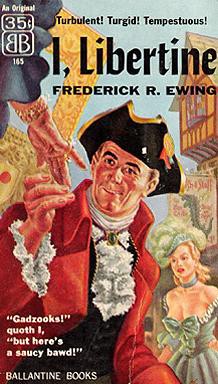
The phones at WOR rang off the hook with reporters wanting Shepherd’s side of the tale. Over the next week, accounts of the hoax appeared around the globe. Shepherd would later note, with obvious pride, that the Wall Street Journal article was the only dispatch from that particular paper to ever appear verbatim in the pages of Pravda. The Night People had stepped out of the shadows, and their first communiqué to the outside world was, in essence: WE’VE ALL BEEN LAUGHING AT YOU.
And then, right at his moment of triumph over the Day World, Shepherd inadvertently blunted the effect of the whole thing. While the hoax was still in full swing, Theodore Sturgeon, a friend and sci-fi author of note (later to write several episodes of “Star Trek”), informed Shepherd that the publisher of Ballantine Books was desperately trying to secure the paperback rights to I, Libertine. The three of them had lunch and decided to produce an actual book with that title, a ribald romp in the mold of Tom Jones.
For a media who felt duped by Shepherd and his listeners, with the related taunt at their omniscience as “tastemakers,” the impending publication of an actual novel called I, Libertine was a godsend. It allowed them to dismiss the hoax as a cheap publicity stunt whose true intent had always been to sell a book. UPI, for instance, described Shepherd as “whimsical” and heavily implied a profit motive to his actions (even though all proceeds from the book went to charity). “When not playing records,” the piece noted, quite incorrectly, “he holds forth on such subjects as the vital role of the ‘flexible flyer’ to America’s cultural renaissance.”
Day People couldn’t conceive of the importance of a radio program about flexible flyers, the once ubiquitous children’s sled. Night People couldn’t conceive of anything more important.
THE “CHRISTMAS STORY” CONNECTION
Ultimately, it didn’t matter — and Shepherd’s skeptical world view would be the one to win out. The years to follow would be molded by people who defined themselves not by the old terms of what school they went to or where their family hailed from, but by their cultural likes and dislikes. Talking about the hoax in 1967, Shepherd noted that after the hoax, people “were never the same in their lives after that. They could never sit seriously and watch the Academy Awards” or take poll results at face value.
Despite that brag, if Shepherd did see a cultural landscape dominated by Night People who questioned lists and tastemakers, and who emphasized pop culture over traditional highbrow pursuits, the evidence suggests he didn’t much care for it. Much like his old friend Kerouac, Shepherd had little love for the kids who took him at his word, then grew up to rule the world. A particularly cringe-inducing show from 1965, for example, mocked a young man who wrote a letter to the editor about his fears of being drafted into the army, while ascribing much anti-Vietnam War sentiment to kids hoping someone else would take care of the world’s problems for them.
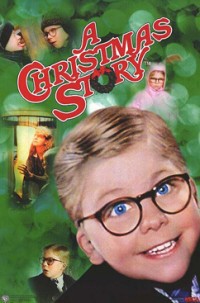
He also suffered under the weight, with him since his early career, of the status of Critic’s Favorite: beloved but ill compensated. (“Writer’s writer” is a similarly financially thankless role.) Shepherd bristled at imitators and joke thieves, both real and imagined. He was the sort of guy who was always there at the start of things, but never the end when the rewards were distributed. Steve Allen himself recommended him as his replacement on “The Tonight Show, and NBC hired Jack Paar instead. He asked listeners to donate money to fund a movie by his friend, a budding filmmaker named John Cassavetes, but Hollywood remained uninterested in him. This may have resulted from all the time he’d spent feigning disinterest in Hollywood, but it didn’t prevent him from expressing resentment against those who made the leap. He was particularly vexed when playwright Herb Gardner, once a friend of his, found huge success on stage and screen with A Thousand Clowns, a play whose main character appeared to be a Shepherd manqué. “It was my life,” he told one reporter. Shepherd was on the radio for hours every week, and he heard echoes of his words in every second-rate standup, none of whom had any trouble eclipsing his fame.
Shepherd’s sense of resentment was fueled by a turnover in his demographics. By the 1960s, his show, whittled down to 45 minutes, had moved to an earlier weekday slot. The programs now focused on tales from his childhood, and the audiences skewed away from beatniks and toward high-school students. Though the shows were as smart as ever, it was hard to shake the label of being a “kids’ show.” He decided he needed to relocate to a less ephemeral, more respected medium. And so Shepherd repurposed some of his radio tales into short stories, largely for Playboy, which were subsequently collected in book form. He even insisted that his first collection, In God We Trust, All Others Pay Cash, was a novel, despite the fact that his stories were prose versions of tales he’d told multiple times on the radio. The stories didn’t quite work as a cohesive whole but he persisted in referring to the compendium as a novel. It just sounded classier.
A Shepherd fan and director, Bob Clark, collaborated with him on a Hollywood adaptation of these stories that would eventually become A Christmas Story. His stories’ sardonic edges were sanded down, and when movie flopped initially, he panned it for its lukewarm approach. He changed his tune when endless repeats on cable TV made him rich. It doesn’t get much more Day World than being responsible for a perennial holiday classic, but as Shepherd discovered with I, Libertine, once you release something into the world, it tends to forge a path of its own.
Along the way, radio fell off Shepherd’s radar. Embittered by an unceremonious dismissal from WOR in 1977, he denigrated his work there at every opportunity thereafter, attempting to consign his radio work to a dark corner where it would never be discussed again. He claimed he came to New York to be an actor, citing his brush with “The Tonight Show,” and fell into radio by accident. He came to consider himself more of a writer than anything else, or at least tell people he did. He repeated this line endlessly in interviews for the rest of his life, even when queried by former Night People who grew up listening to his every word and knew better. They were the ones he’d taught not to believe everything they heard.
1 Take, for example, this show about an enormous blizzard he lived through as a kid in Hammond.
2 This monologue he delivered at one of his pre-New York radio posts, later transcribed in Marshall McLuhan’s Explorations in Communication, gives an idea of what Shepherd’s early performances were like, and how ill-equipped execs of the time must have been to judge them.
3 You can listen to one of the segments here; it’s extraordinary to think this ever happened on the radio, let alone in the mid-50s.
If you’d like to listen to more shows, check out the Brass Figlagee podcasts, which has hundreds of shows for download. Shows are also available at the fansite flicklives.com, which contains an excellent collection of Shepherd-related items, many of them invaluable in writing this article.
Matthew Callan writes about the New York Mets for Amazin’ Avenue and has written about everything else for McSweeney’s, The Classical, Vice, Low Times, Splitsider, and his own blog, Scratchbomb.com. He is also the host of Replacement Players, a new podcast about old games. Catch him on Twitter at @scratchbomb.
